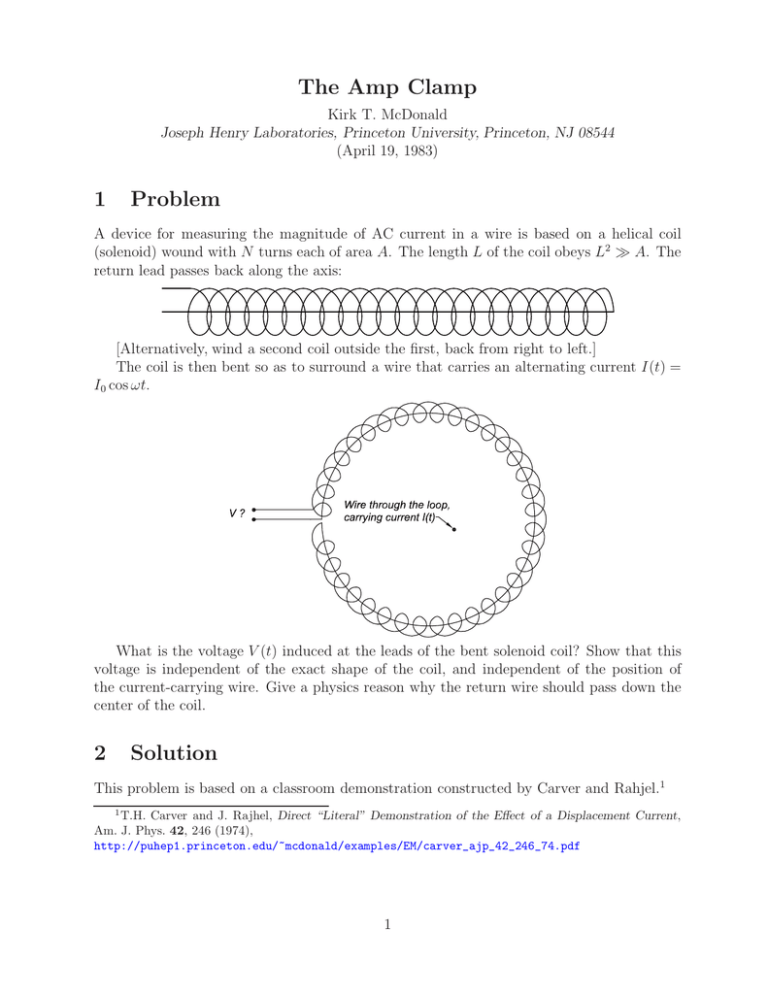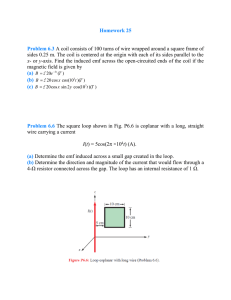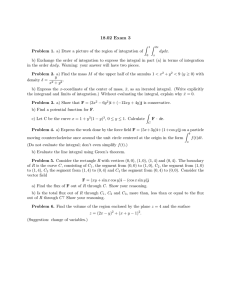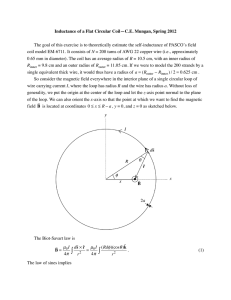The Amp Clamp - Physics
advertisement

The Amp Clamp Kirk T. McDonald Joseph Henry Laboratories, Princeton University, Princeton, NJ 08544 (April 19, 1983) 1 Problem A device for measuring the magnitude of AC current in a wire is based on a helical coil (solenoid) wound with N turns each of area A. The length L of the coil obeys L2 A. The return lead passes back along the axis: [Alternatively, wind a second coil outside the first, back from right to left.] The coil is then bent so as to surround a wire that carries an alternating current I(t) = I0 cos ωt. What is the voltage V (t) induced at the leads of the bent solenoid coil? Show that this voltage is independent of the exact shape of the coil, and independent of the position of the current-carrying wire. Give a physics reason why the return wire should pass down the center of the coil. 2 Solution This problem is based on a classroom demonstration constructed by Carver and Rahjel.1 1 T.H. Carver and J. Rajhel, Direct “Literal” Demonstration of the Effect of a Displacement Current, Am. J. Phys. 42, 246 (1974), http://puhep1.princeton.edu/~mcdonald/examples/EM/carver_ajp_42_246_74.pdf 1 The changing current in the wire causes a changing magnetic field, which induces an electric field, according to Faraday. The voltage V at the leads to the amp clamp coil is V = E · dl = − 1 dΦM , c dt (1) where the magnetic flux link by the amp clamp is ΦM = small loops B · dA ≈ large NA dN dl B · l̂A ≈ L loop dl large loop B · dl = 4π NA I(t). (2) c L We have used Ampere’s law in the last step of eq. (2), assuming it to hold in its static form for low-frequency currents as well. For current I = I0 cos ωt in the wire, the voltage in the amp clamp is therefore 4πNAωI0 sin ωt V (t) = . (3) c2 L Note that we do not have to include a term in ΦM due to flux linked by the large loop – because of the return wire down the center of the small loops the amp clamp does not link any flux due to magnetic field lines perpendicular to the plane of the clamp. Rather, the use of Ampere’s law in eq. (2) shows that the clamp links flux only for wires that pass through the clamp, and that the amount of this flux linkage is independent of the position of the wire relative to the clamp. Further, the amount of flux linked is independent of any possible tilt of the wire with respect to the plane of the clamp. Mathematical footnote: It may be instructive to make an explicit calculation of the flux linked by the amp clamp due to a wire perpendicular to the plane of the clamp at distance a from its center. The clamp has radius R. We first consider a small loop of area A such that the radius vector R to this loop makes angle θ to the vector a that points from the center of the loop to the wire. The flux dΦ through this loop due to current I in the wire is dΦ = B · A = 2 2IA r̂ · R̂, cr (4) where the distance from the wire to the loop is √ r = R2 − 2aR cos θ + a2. (5) Since r = R − a, we have r̂ · R̂ = R − a cos θ R−a · R̂ = , r r (6) And the flux linked by the small loop is dΦ = 2IA R − a cos θ . 2 c R − 2aR cos θ + a2 (7) The total flux linked by the amp clamp is obtained by integration over θ, noting that the number of turns in interval dθ is Ndθ/2π: Φ= NIA dΦ = πc 2π 0 dθ R2 R − a cos θ . − 2aR cos θ + a2 (8) We recognize this integral as one suitable for evaluation by contour integration. In particular, we consider the integral around a loop of radius R of the complex function f(z) = 1/(z − a). The function f has a simple pole at z = a with residue 1, so if a < R the integral is simply 2πi, while if a > R the integral is zero. On the circle of radius R we write z = Reiθ , so that 2π 2π 2π dz iReiθ dθ dθ dθ = iR = = iR iθ −iθ z−a Re − a R − ae ⎧ R − a cos θ + ia sin θ 0 0 0 2π = iR 0 ⎪ R − a cos θ − ia sin θ ⎨ 2πi, a < R, dθ 2 = ⎪ R − 2aR cos θ + a2 ⎩ 0, a > R. Thus, ⎧ ⎪ ⎨ 2π 0 (9) dθ R2 2π/R, a < R, R − a cos θ = 2 ⎪ − 2aR cos θ + a ⎩ 0, a > R, (10) and eq. (8) yields Φ= 2NIA 4πNIA = , cR cL and Φ = 0 for a > R. 3 a < R, (11)





